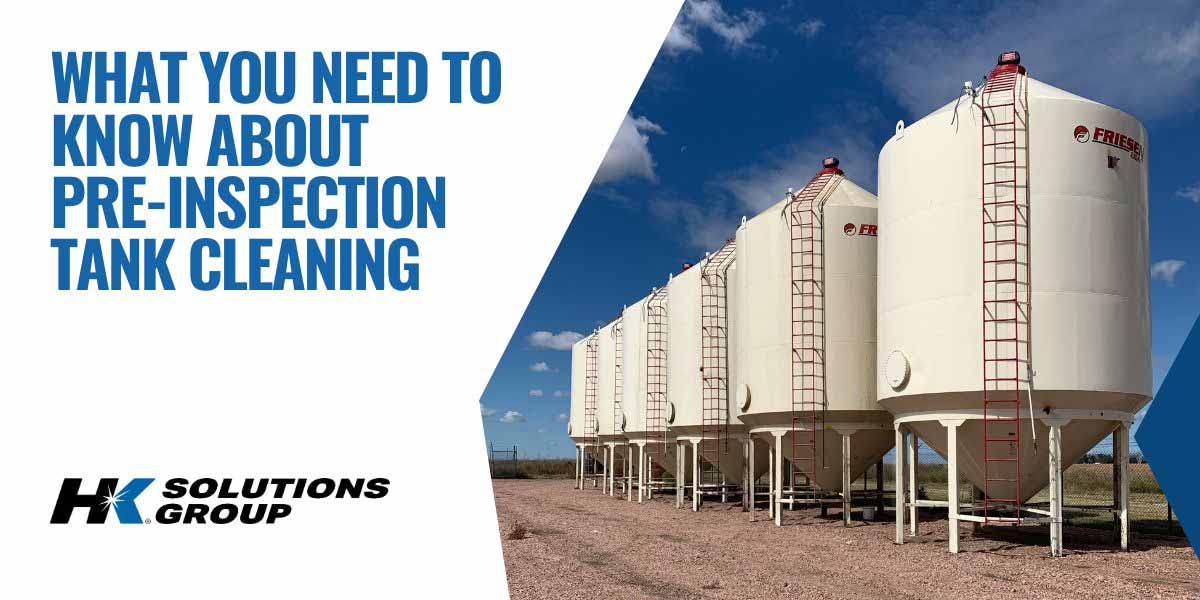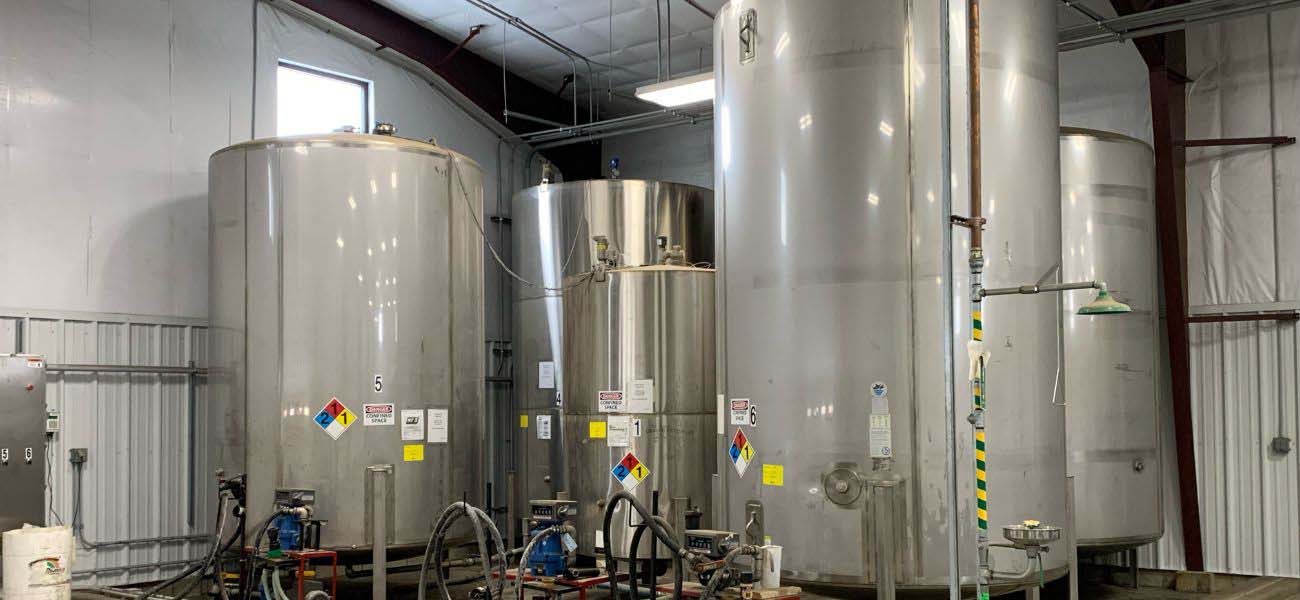What To Expect From Industrial Tank Cleaning Before A Tank Inspection
October 22, 2024

Many of the world’s top commodities come from industrial facilities working day in and day out to meet demand for consumers: Chemicals, Plastics, Metals, Energy, Paper, Oil and Food. Each of these processes follows a unique path and set standards from start to finish, but one thing most industrial operations have in common is the need for storage. There’s no question process and storage tanks play a critical part in production, but their importance also makes them a liability if not properly maintained. Tank inspections and integrity testing are two components needed to earn periodic tank recertification proving your business is operating with safe and reliable vessels.
But before inspectors can begin a process or storage tank inspection, the tank must be clean and free from contamination. Inspectors need full access to adequately certify the continued safety and performance of the tank in question. Industrial tank cleaning is a necessary step in the certification and inspection process, with no room for error. Creating a safe and productive work environment around large storage vessels depends on attention to detail and preparation leading into a formal inspection, as well as routine tank maintenance services to continue optimal performance.
How Often Do Industrial Tanks Need To Be Inspected?
Tank inspection frequency depends on each vessel, including what kind of tank it is, the items it stores, how long it’s been active and the certification standards it qualifies for. The general consensus between the STI and API standards committees is external inspections every five years and internal inspections every 10 to 20 years.
The Steel Tank Institute (STI) and American Petroleum Institute (API) are two of the main bodies regulating the manufacturing and maintenance of aboveground storage tanks in the United States. External inspections are required more frequently to catch issues like corrosion, leaks and structural deformities outwardly present, but tanks can typically remain in operation throughout the inspection.
Internal storage tank inspections are a bit more involved and require vessels to be shutdown and fully cleaned out. Initial recertification calls for internal inspections of storage tanks after 10 years from the tank’s construction. Assuming the tank is found to be in good condition at this first evaluation, inspection frequency typically decreases to every 20 years. But for your business, safety is rightfully an ongoing commitment outside of meeting certification requirements. Your operations will benefit from more frequent inspections, at least informally, to ensure safety and efficiency. Industrial tank cleaning and inspections are both essential tank maintenance services your business should invest in to help vessels remain on track in the meantime. Start by familiarizing yourself with what professional inspectors look for so you know your business is meeting the highest possible safety standards day in and day out.

What Inspectors Look For During A Storage Tank Inspection & Integrity Test
During a professional tank integrity test, inspectors evaluate the tank’s interior, exterior and structure including the foundation, process valves, pipes and connected equipment. They look for signs of damage or defects like corrosion, leaks, cracks, residue buildups and other deficiencies that put your facility at risk. Essentially, formal inspections determine whether or not tanks are suited to continue performing safely for the next 10-20 years based on their current condition. The goal is to avoid potential hazards caused by failing tank systems unable to withstand long-term performance in a facility.
The two main storage tank inspection standards are the STI SP001 and API 653, both of which have varying requirements depending on the type of tanks operating at your facility. An STI SP001 inspection primarily applies to smaller, shop-fabricated vessels, including concrete and steel structures, while the API 653 standard is better suited for large, field-erected tanks. If you’re unsure about which requirements your tanks fall under, a professional inspector should be able to help you determine the right regulations. Either way, the first step in preparing for an upcoming tank integrity test is to follow a detailed tank cleaning procedure to ready the tank for evaluation.
Professional Storage Tank Cleaning Procedures & Expectations
Storage tank cleaning isn’t something you should save solely for upcoming tank inspections. Facilities should ideally have routine tank maintenance services performed annually, which includes cleaning the vessel out. However, cleaning before a tank integrity test requires even more precision to get the vessel inspection-ready. Because industrial tank cleaning requires confined entry and high-power equipment like hydroblasters and vacuum trucks, facility planning teams should work with professionals specializing in tank maintenance. The pre-inspection tank cleaning procedure includes several core steps that help set up vessels for a smooth evaluation.
Step 1. Prepare Storage Tanks For Cleaning
The first step in a thorough tank cleaning process for industrial facilities is to drain or empty the tank. Tank maintenance service partners start the tank cleaning process by carefully removing liquid and solid materials, both hazardous and non-hazardous, from the vessel using vacuum trucks or pumping equipment. If your facility needs to preserve materials within the tank, be sure to communicate this with your tank cleaners so they don’t destroy products that are still intended for use. Ask if they have storage capabilities to temporarily store materials and assist with re-introducing them to the tank once both the cleaning and inspection are completed.
Step 2. Ensure Tank Cleaning Procedure Can Be Conducted Safely
Next, industrial tank cleaners disconnect the tank from surrounding operations, rendering it inactive. To make sure storage tank cleaning proceeds without risking the performance and safety of facility operations, all connected valves and pumps are shut off from the tank. Tank inspections are planned in advance, which means your facility will have plenty of heads up to hire maintenance services and prepare the vessel for inspection, which is better than an unplanned shutdown due to tank issues that go undetected.
Cleaners also neutralize any chemical hazards or harmful gasses before cleaning begins. Tanks provide a controlled environment for chemical interactions to occur safely. So when tanks are removed from operation, there may be remaining gasses trapped inside unable to get out. Professional storage tank cleaning companies account for dangerous vapors to be in the air and mitigate the risk with mechanical ventilation equipment like fans.
Step 3. Use High-Pressure Hydroblasting Equipment To Perform Industrial Tank Cleaning
Both traditional power washing equipment and advanced hydroblasting equipment have the ability to blast interior tank surfaces using only a targeted water stream to remove residue from tank floors and walls, chemical-free. Professional storage tank cleaners should have experience and training in confined-space entry to access tank interiors safely and complete the tank cleaning procedure quickly. Working with a reliable partner for tank maintenance services is a necessary step in the process so no facility employees are put at risk. Professionals have the expertise, equipment and well-practiced safety protocols in place to perform the job efficiently and effectively.
Step 4. Dry Tank Completely Prior To The Integrity Test
Before a tank inspection can begin, the tank must be dry and free of all vapors prior to entry and evaluation by an inspector. Trusted cleaners will check the roof and tank seals to ensure there is no stubborn residue or vapors remaining. If moisture or residue is still present, vacuum trucks can be used again to absorb any remaining moisture so mold and other contaminants can’t be introduced leading up to the inspection.
How Ongoing Tank Maintenance Services Better Position Process & Storage Vessels To Meet Certification Standards
A lot can happen to tank performance in the five to 20 years between formal tank inspections and integrity testing, so facilities must do their own due diligence to maintain process and storage vessels in the meantime. Routinely scheduled tank maintenance services can include informal inspections and storage tank cleaning to keep tanks functional and compliant. At HK Solutions Group, we recommend facilities undergo industrial tank cleaning at least once a year, though two times a year or more frequent tank cleaning procedures may be needed depending on the tank and its materials. To ensure your operations remain safe and productive, look for a long-term tank maintenance partner who has confined space experience, advanced equipment and a proven track record for prioritizing operational safety and peace of mind.

HK Solutions Group is a leading industrial service provider serving industrial facilities and municipalities across the United States. Our expertise includes silo cleaning, industrial hydroblasting, plant cleaning and tank maintenance services. We employ powerful hydroblasting equipment in our tank cleaning procedure to blast away contamination and residue with pumps operating at up to 40,000 PSI. HK technicians have extensive training in confined space entry, but as a full-service industrial partner, our team also has both hazardous and non-hazardous waste removal experience. This experience allows us to operate a fleet of vacuum trucks to carry waste to a treatment facility or transport tank materials to a temporary storage facility while we perform storage tank cleaning.
After we’ve carefully washed and dried every square inch of the tank, we’re happy to help with product re-introduction to get your operations back up and running. And when the time for recertification and tank integrity testing approaches, we’ll be ready to jump into action to prepare your tanks to pass all quality checks, no problem.
Ensure Your Facility Is Up To Code With HK Solutions Group’s Tank Cleaning & Industrial Services
Whether you’re looking to preserve tank performance with tank maintenance services or preparing for an upcoming tank inspection and recertification, HK is your trusted industrial partner for the job. To learn more about our tank cleaning procedure or industrial best practices for successful integrity tests, call our team at (515) 283-0500 or contact us online today.
Get Started With HK